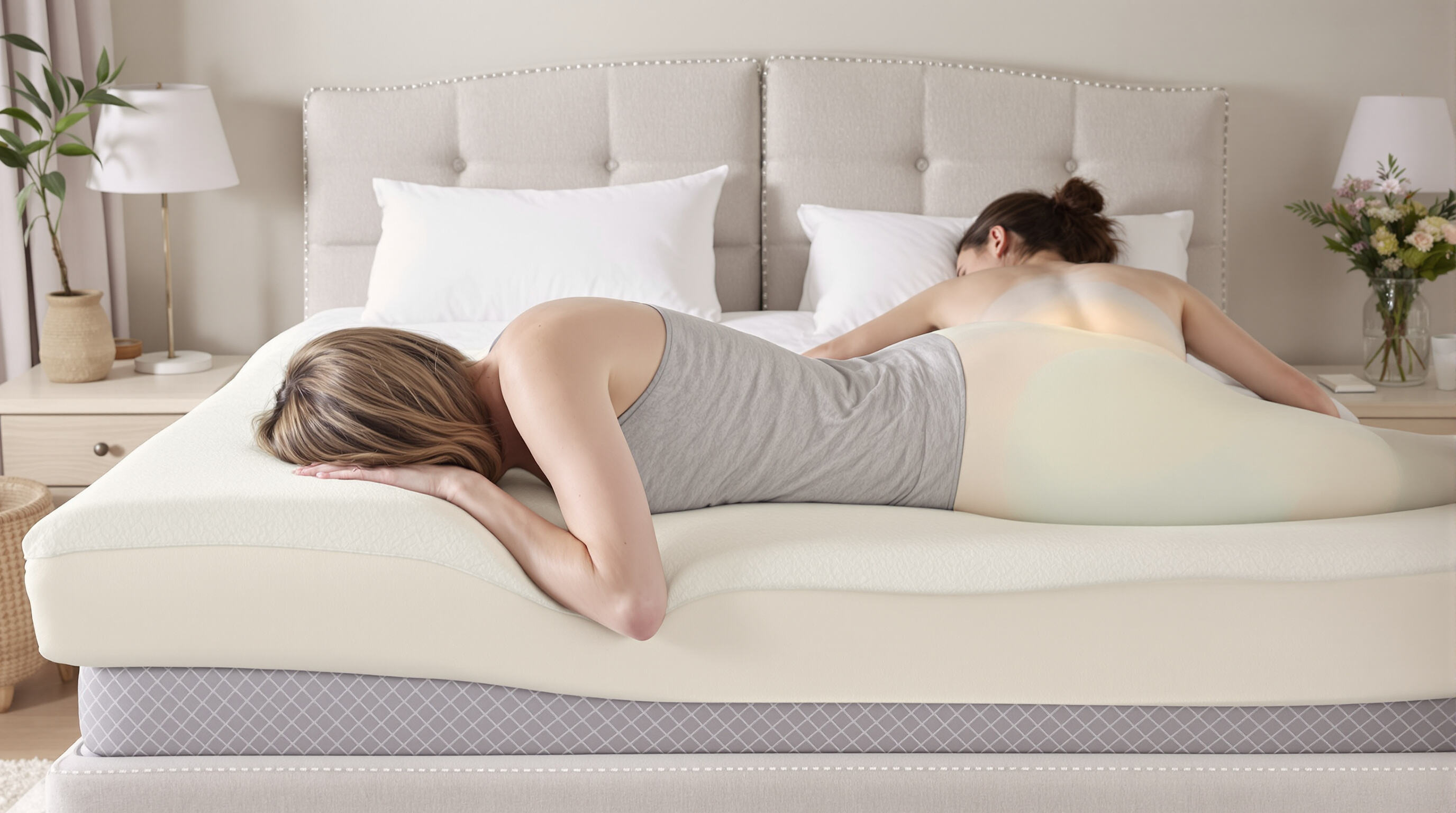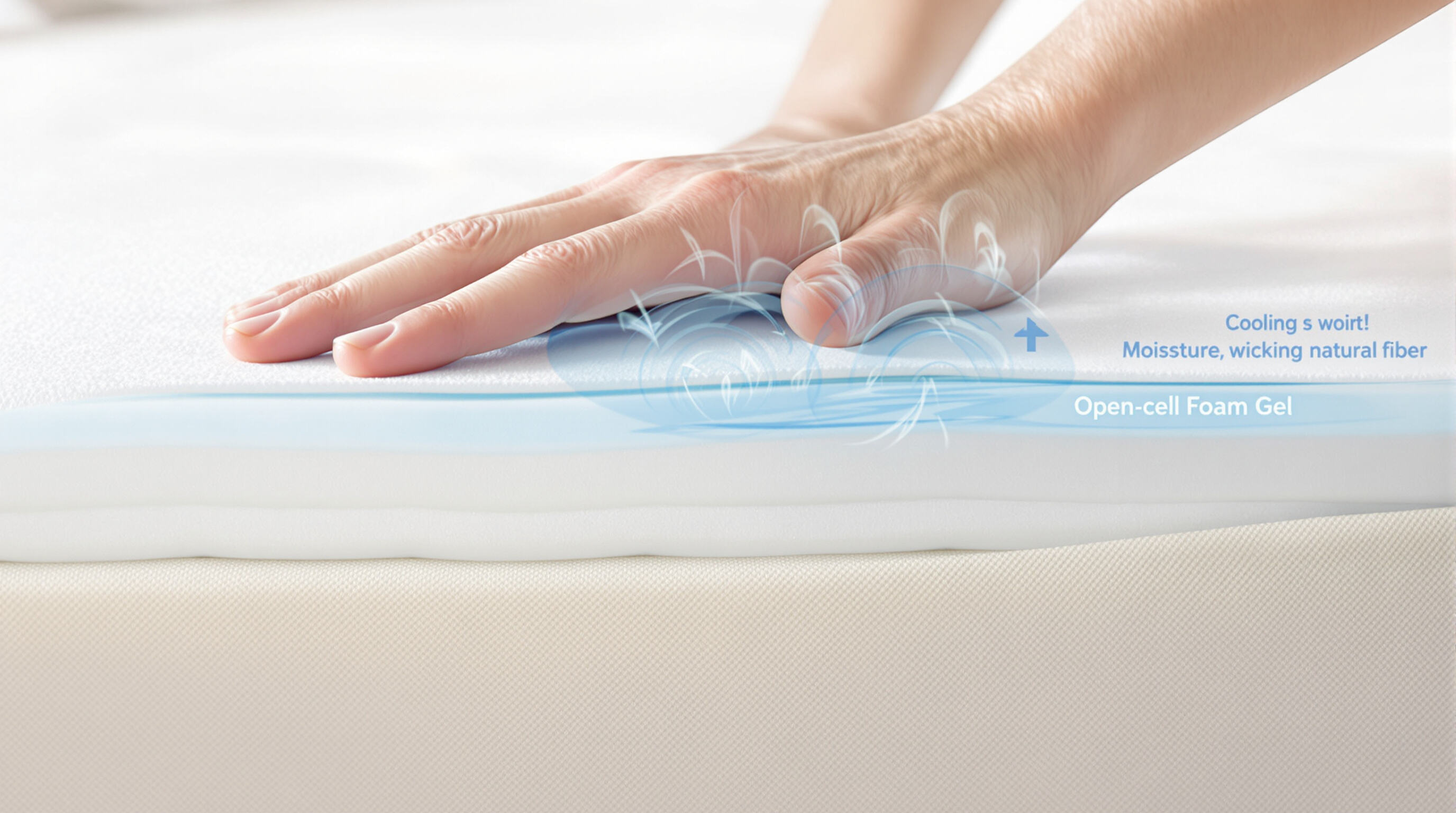Mattress toppers designed with ergonomics in mind actually improve how well someone sleeps because they mold around the body's shape, spread out weight better, and take pressure off spots that usually cause tossing and turning at night. The stuff they're made from matters too – memory foam works great for this since it molds right into those spinal curves but still gives solid support where it counts. Some studies have found that when people's spines are properly aligned during sleep, their REM cycles get longer by maybe around 15 percent according to Sleep Health Journal last year. Regular old mattresses just don't do this same thing. These special layers cut down on waking up throughout the night and keep things comfortable no matter what position someone ends up sleeping in.
The best mattress toppers come with advanced cushioning that focuses on those trouble spots we all know too well – our shoulders, hips, and lower back area. Materials like memory foam and natural latex work wonders by soaking up pressure where our bones stick out most, keeping our spine properly aligned so joints don't get squashed under body weight. Some interesting research looked into how these pressure relief technologies actually perform, and guess what? They saw around 30 percent less strain on tissues than regular old mattresses do. What does this mean for sleepers? Well, the whole night long, these materials adjust themselves to our changing positions, which makes waking up feeling stiff and sore just not happen as much anymore.
Getting good support really comes down to what works for each person's body. People who weigh more tend to do better with firmer latex cores since they don't sink into them as much, while those with lighter builds often find softer, less dense foam gives them the pressure relief they need. Side sleepers usually want something that contours deeply around both shoulders and hips so everything stays aligned properly during the night. Stomach sleepers are different though—they generally prefer something flatter but still supportive enough to keep their spine straight. Folks who get hot at night might want to look into open cell foam options because these materials let air circulate better and actually cool things down quite a bit compared to regular foam. All this variety means people can fix their particular comfort issues without having to buy an entirely new mattress every time there's a problem.

People who sleep on their sides tend to wake up sore in spots like their shoulders and hips, places where most folks actually feel some kind of pain while sleeping at night. According to recent studies, about three quarters of adults deal with discomfort in these pressure points when they get enough rest. That's why mattress pads filled with memory foam work so well for side sleepers. The material molds around those trouble spots, spreading out body weight better and helping maintain proper spinal alignment all the way down from head to tailbone. Research has found that using these specialized mattress covers can cut down morning stiffness by roughly 40 percent over regular old flat mattresses.
For back and stomach sleepers, preventing midsection sagging is crucial to maintaining healthy spinal curvature. Medium-firm toppers with zoned support help preserve cervical and lumbar alignment within the optimal 20–40 degree range. Studies indicate this consistent support reduces disc compression risks by 31% over an 8-hour sleep cycle.
A 2023 study found that individuals using posture-correcting mattress toppers reported 58% less chronic lower back pain and 42% fewer episodes of hip stiffness after six months. By maintaining stable spinal alignment through all sleep movements, these toppers prevent the micro-strains that accumulate in muscles and joints, leading to long-term pain reduction.

Modern mattress toppers use advanced materials to manage heat and moisture, ensuring a cooler, more comfortable sleep environment.
Gel infused foam actually has tiny bits of titanium or ceramic mixed in that work to soak up and spread out body heat. Then there are these phase change materials, called PCMs for short, which do something pretty clever too. When things get too warm, they melt and take in the extra heat, then later when it's cooler, they turn back into solids and let that stored warmth escape again. Combined, these two technologies keep our skin at around the right temperature between about 28 to 32 degrees Celsius, which is what we need for good sleep through the night. Some studies looking into this show that beds with PCM technology might cut down on waking up during the night by roughly 18 percent compared to regular mattresses.
Natural fiber covers such as those made from Tencel™ and bamboo help pull sweat away from our skin, which means less discomfort from built up perspiration during wear. Beneath the surface, there's something pretty clever going on too. The open cell foam has tiny connected air spaces throughout it, allowing air to keep moving constantly. According to some testing in labs, this actually makes for around 50 percent improved breathability when compared with regular memory foam products we see everywhere else. And what does all this mean practically? Well, people who have tried them report feeling cooler since their body temperature stays about 3 to 5 degrees Fahrenheit lower than with other materials that don't breathe so well.
Putting together moisture wicking fabric layers with either thermoregulating gels or phase change materials along with some open cell foam makes for pretty effective cooling systems. The whole layered setup stops excess heat buildup that would normally mess with those important REM sleep stages. Research on sleep patterns shows that when temperatures stay stable during the night, people tend to experience around 12% less fluctuation in their heart rates. This stability helps most folks get into deeper sleep states faster and stay there longer through the evening hours.
The Sleep Foundation did some research in 2024 and found that about two thirds of people who own mattresses are getting an extra three to five years out of them just by adding good quality toppers. What these extra layers do is pretty simple really they fill those annoying dips where the mattress has started to sag and give support back to areas that have become weak over time. When we look at the materials, top tier options made with dense memory foam or solid latex tend to hold up much better. They only break down around 5% each year, which beats the pants off cheaper alternatives that can actually shrink by as much as 12% in thickness yearly according to data from the Sleep Products Association last year. This kind of longevity means both the topper itself and whatever mattress sits underneath lasts longer before anyone needs to shell out money for a complete replacement.
Replacing a mattress typically costs $1,200–$2,500 (ISPA, 2024), while most sleepers achieve comparable comfort improvements with a $150–$400 topper. Toppers are ideal for addressing:
However, if a mattress has severe sagging (>2") or exposed coils, replacement is recommended. Cost-benefit data shows that pairing a $300 topper with an existing bed improves sleep quality 28% more cost-effectively than buying new (Sleep Economics Report 2023).
Choosing the right material impacts pressure relief, support, and temperature control. Here’s how the top options compare.
Memory foam works because it has this special property called viscoelasticity that lets it mold around our bodies over time. Most foams will adjust to new positions in about 5 to 15 seconds when we move around during sleep. The way memory foam wraps around us helps spread out body weight pretty evenly across the mattress surface. This takes pressure off sore joints and stops movements from traveling through the bed, which is why so many couples love it. Older memory foams had a reputation for getting really hot at night, but these days manufacturers have added things like cooling gel layers or created special cell structures that let air flow better. People who deal with chronic joint pain often find memory foam particularly comfortable since it feels like being gently hugged by the mattress itself.
Natural latex comes straight from the sap of rubber trees and gives that instant response feel while still holding up well without sinking too much. The way it's structured with those tiny air pockets lets good airflow through, so it doesn't trap heat against the body. Most quality latex mattress toppers can stick around for about ten years before showing signs of wear. For people who tend to get warm during the night or anyone sleeping on their back or stomach looking for something firm but comfortable, these toppers really stand out as a great option.
The best hybrid mattress toppers combine what memory foam does so well (molding to the body) with the springy feel of latex. They have these special middle layers that keep things cool without sacrificing the connection between soft spots and firm areas. People who switch sides during the night or have different weight distributions find these work really well for them. A recent look at sleeping surfaces from last year showed something interesting too many folks discover on their own the hard way hybrids just perform better overall compared to regular old foam or straight latex alone.
Mattress toppers improve sleep comfort by providing pressure relief, maintaining proper spinal alignment, enhancing support based on body type and sleep position, and regulating temperature.
Mattress toppers help reduce back and joint pain by cushioning pressure points and providing stable spinal alignment, preventing muscle and joint micro-strains.
Yes, a quality mattress topper can extend the lifespan of an older mattress by adding support to sagging areas and filling body impressions, enhancing comfort without needing a full replacement.
Common materials for mattress toppers include memory foam, latex, and hybrid combinations. Each offers unique benefits like contouring support, responsiveness, cooling properties, and motion isolation.
Temperature is regulated in mattress toppers using advanced materials like gel-infused foam, phase-change materials, and breathable covers, which help manage heat and moisture.
 Hot News
Hot News2025-09-04
2025-09-02
2025-09-01
2025-07-08
2025-06-10
2025-11-27